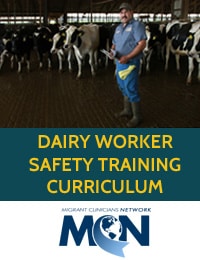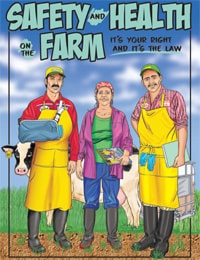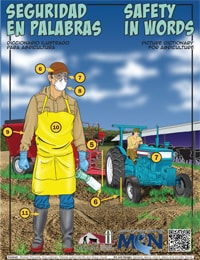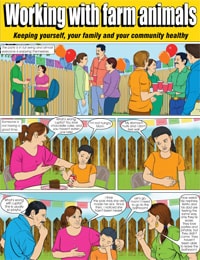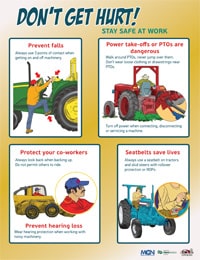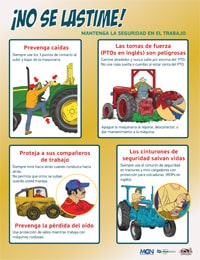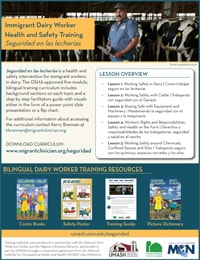Seguridad en las lecherías, a health and safety intervention for immigrant dairy workers, was first developed in Wisconsin between 2011 – 2016. As part of this successful program, 67 farms participated and 850 workers were trained. This award winning project uses a popular education model that includes worker training and promotores de salud (or Community Health Workers) to reduce worksite hazards and to improve worker knowledge and practices. Through extensive input from workers, health and safety professionals and researchers, this project developed an OSHA-approved five-module, bilingual health and safety training curriculum. The curriculum includes background sections on each topic and a step by step facilitators guide with visuals either in the form a power point slide presentation or a flip chart.
The program has now expanded to Minnesota using the same format. The Minnesota project, Promoting Safety and Worker Health for Immigrant Dairy Workers, consists of trainings in Spanish, at no cost, to dairy workers on health and safety issues held during times convenient to the farm operations.
Both projects address safety and health issues beyond worker training and include components to engage the veterinarians and to help producers reinforce safety messages and make their farms safer.
LESSON OVERVIEW
- Lesson 1: Working Safely in Dairy | Como trabajar seguro en las lecherías
- Lesson 2: Working Safely with Cattle | Trabajando con seguridad con el Ganado
- Lesson 3: Staying Safe with Equipment and Machinery | Manteniendo la seguridad con el equipo y la maquinaria
- Lesson 4: Workers’ Rights and Responsibilities: Safety and Health on the Farm | Derechos y responsabilidades de los trabajadores: seguridad y salud en el rancho
- Lesson 5: Working Safely around Chemicals, Confined Spaces and Silos | Trabajando seguro con los químicos, espacios cerrados y los silos
You may download each module to view its content or request power point versions or flip charts by visiting www.migrantclinician.org/seguridad. For additional information about accessing the curriculum contact Amy K. Liebman at aliebman@migrantclinician.org.

Safety is the elephant in the room and it’s overwhelming for someone in my position. [This program] .. breaks it down so that we can tackle it one thing at a time.
Our employees are definitely utilizing the information learned in this training. Our workers really pay more attention to safety. This program helped our employees realize that we care about their safety and their well-being as people, not just as employees.
The follow-up training and direction was so appreciated because of the warm, personable and cost effective service provided.
Our employees are like family and they are what make our farm get the work done everyday. It is a great way to show we care and we do.
It empowered people in the trenches to have the resources to bring to their team members on a regular basis. They know what is needed.
I would definitely recommend a program like this. It gets you in touch with people that can get resources to you if you need help with training.
 Can COVID-19 infect my herd, flock, or pets?
Can COVID-19 infect my herd, flock, or pets?
According to the CDC, humans seem more likely to give COVID-19 to animals than vice versa. A limited number of animals in the United States have been infected with COVID-19.
https://www.aphis.usda.gov/animal_health/one_health/downloads/sars-cov2-in-animals.pdf
If you are sick, restrict contact with pets just as you would around other people. It is suggested that people with COVID-19 limit contact around all animals until more information is known about the virus and the susceptibility of various animals to the virus.
At this time, it appears that livestock or poultry are unlikely to get SARS-CoV-2 infection nor transmit the virus to humans.
COVID-19 in animals that have been confirmed by USDA’s National Veterinary Services Laboratories.


